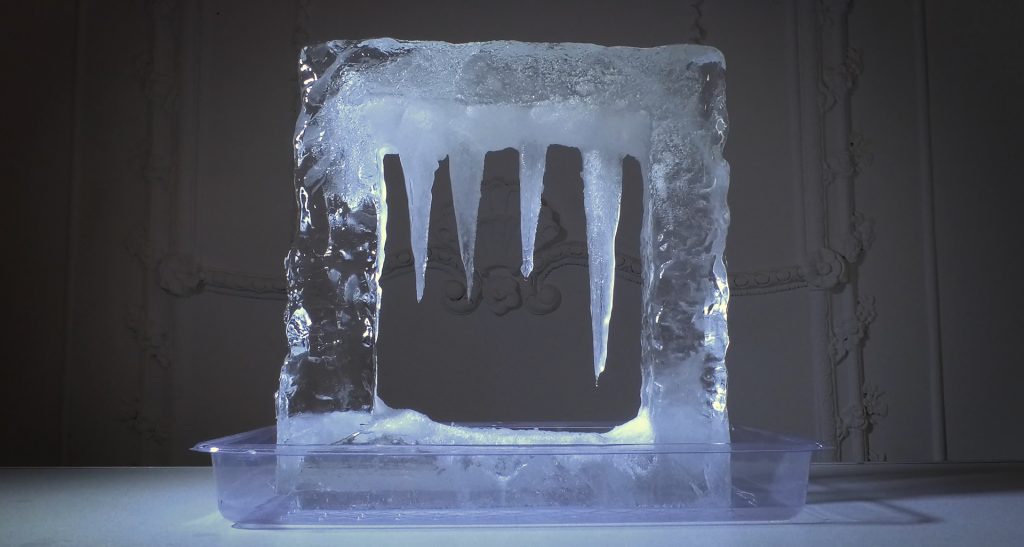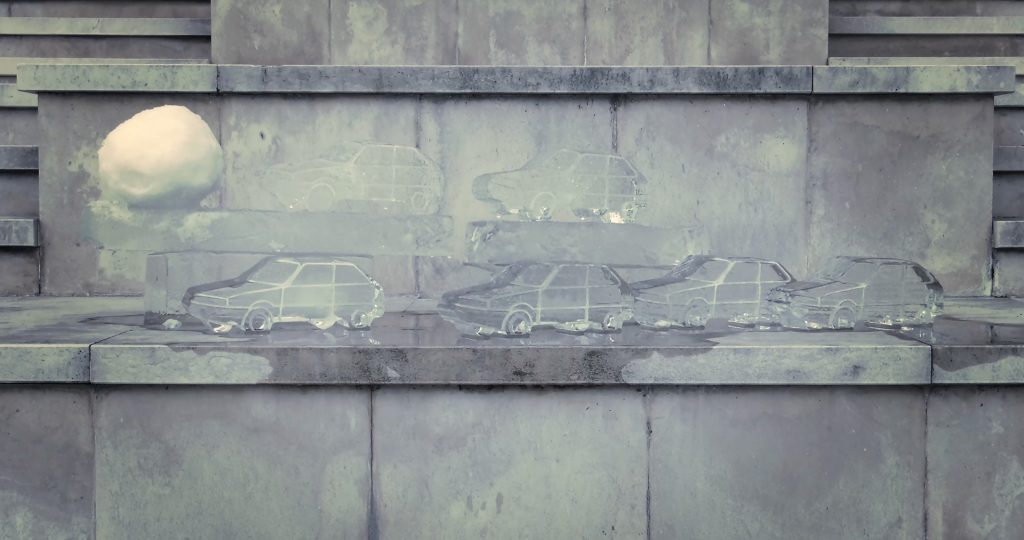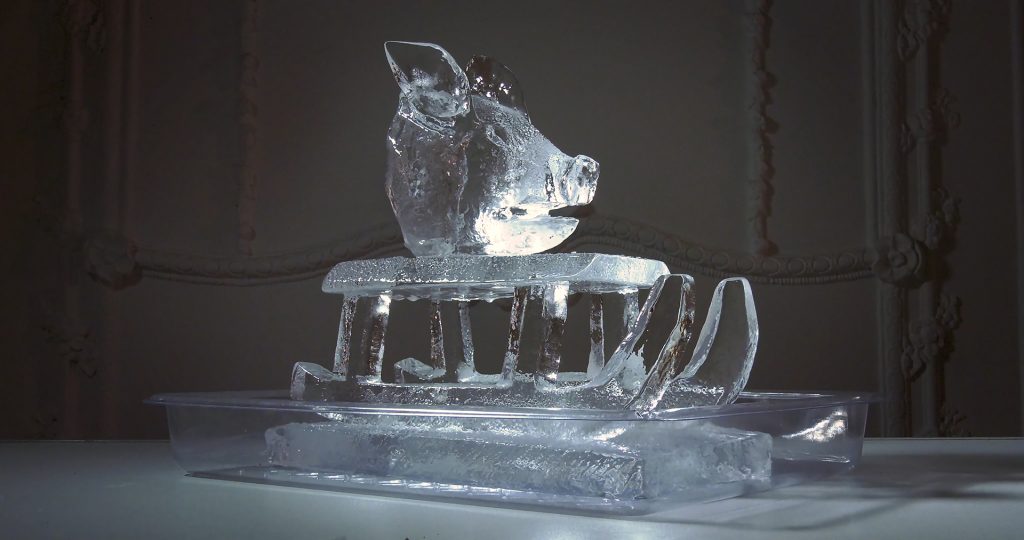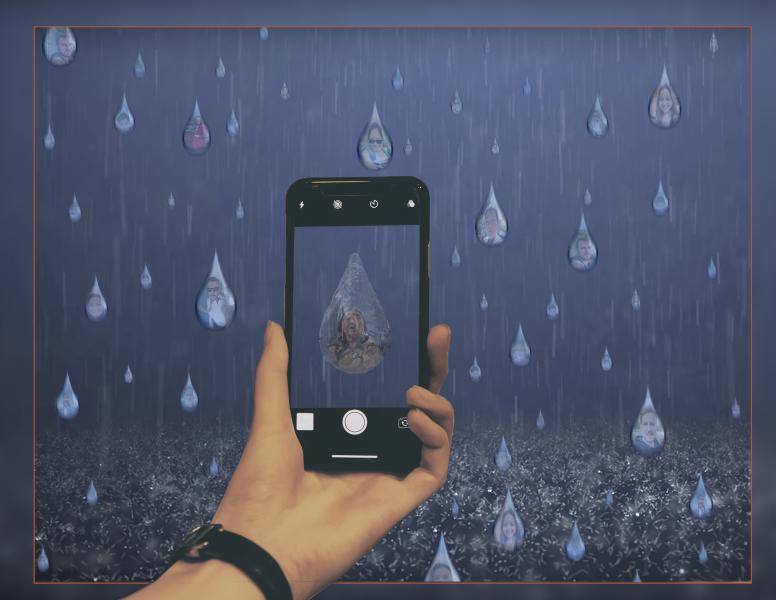On View: January 23 – March 3, 2021
Losing Winter is a participatory artwork and archive of memories and emotions about the season of winter, providing a window onto personal loss in the face of climate change. At the heart of the project are video and audio recordings of memories from participants about a winter from their past. Intertwined with these memories are details of personal, political, and historical events, familial and cultural customs, emerging naturally as a consequence of the particular memory shared. Losing Winter was first realized with the National Museum of Contemporary Art (MNAC) in Bucharest, Romania in 2018. At the center of this realization of the project are audio recordings of memories from 130 participants ranging in age from 8 – 85 about a winter from their past. In addition to the audio recorded memories, the project in Bucharest included Melt, a video featuring a series of unique ice sculptures created in response to selected memories positioned in key locations in and around the museum.
Cazabon is also currently developing a mobile app for the project. In the Losing Winter app, users can experience the memories of others through an augmented reality interface. Holding up their mobile device, users will see a shower of rain drops overlaid onto the scene in which they are standing. Embedded inside each drop is an individual memory, seen as a still frame from a video encased in the droplet. Tapping once on the screen will temporarily freeze several drops and tapping a second time enlarges a drop and plays the video of the associated memory. Users can create an account to record and contribute their own memories. For the exhibition at the Oresman Gallery, Cazabon will collect memories from the Smith College students and from people in surrounding communities.
Smith College Professor of Art Alex Callender, Director of the Oresman Gallery, interviewed Cazabon about Losing Winter and its relationship to Cazabon’s broader art practice.

Alex Callender: Can you talk a little about the connections for you between memory and winter, or specifically, memory and ice?
Lynn Cazabon: In Losing Winter, I’m using the season of winter as a lens through which to focus attention on climate change as it is unfolding right now within individual lifetimes. By asking people to share a memory connected to winter in a particular place, I am also inviting them to reflect on how things may have changed across time and how they feel about that. But there is a twist at the heart of this project: we often think of the weather on a particular day as something in the background, in front of which the events of our lives are occurring. In asking for memories connected to the weather, I am drawing attention to that background that is in fact woven into every aspect of our lives. In reality, climate change is already bringing weather into the foreground of our lives through extreme weather events that are becoming more commonplace. At the same time, I know that weather and climate are not the same thing: weather is the expression of atmospheric conditions at a particular point in time whereas climate is the pattern of those conditions across a longer period of time. A nice analogy is weather is mood whereas climate is personality. Nonetheless, our expectations of the seasons, when they change, what weather events occur within them, is an aspect of climate that we can observe and track within our own lives.

My goal with the project is to build an archive of memories and emotions about the season that can be experienced by others now and into the future. In the first iteration of Losing Winter, which I realized in 2018 in Bucharest, Romania with the National Museum of Contemporary Art, I was able to visualize some of the memories I collected in the form of ice sculptures which were created for a video I made called Melt. In the video, each of the sculptures are positioned in different parts of the museum and are shown in time-lapse in the process of melting. The connections I was making here include the ephemeral nature of memory paired with the ephemeral nature of ice, the loss of winter as we have known it, and connecting those ideas to glaciers melting in different parts of the world. The melting ice sculptures are ephemeral monuments to the winter we are all losing.
Melt, 7 min 17 sec, 2018
AC: How does site and location affect your projects?
LC: Many of my projects are site-specific: they are designed to incorporate and reflect aspects of the community and place in which they are situated. With Losing Winter, it is even more location specific as the project requires the participation of local people. At the Oresman Gallery, I hope to create an exhibition that includes the memories of members of the Smith community as well as people in the surrounding community. In particular, I want the project to bridge generations, so that for example Smith College students will have the opportunity to connect with older residents of Northampton through the exhibition.

AC: There is a participatory aspect to some of your projects, can you talk a bit about how working with people became part of your practice?
LC: Yes participation is an aspect of several of my projects and has become increasingly important to me. I think of it as an exchange between myself and people from particular communities that is at the heart of the work I create. It’s important to me that the exchange is transformative in some way, such as we (myself and the participant) gain an insight or learn something new. Participation is also an action that is manifested as something concrete in the project. In Losing Winter, the recorded memory is what the participant shares with me, which is archived within the project but also potentially generates other outcomes (other forms of participation, objects, video, etc). I’m also currently working on a realization of the project with the Maryland Center for History and Culture which will include a selection of photographs and films from the past 100 years that show winter in Maryland. These will be shown with video recorded memories from people in Maryland.

AC: There are many different processes that you explore in your work, can you talk a little about materials and your approach to selecting those materials based on a given idea or concept?
LC: I would say that I am a conceptually-driven artist: ideas or themes lead me to choose media and materials I work with. My first medium, the one I studied the most and worked with, is photography, which continues to play a role in my work literally and metaphorically. For example, for the first iteration of Losing Winter, I thought of the ice sculptures as three-dimensional photographs, as an image of a memory frozen in time. But the transitory nature of ice required a time-based media so I turned to video. At some point in the process, I proposed displaying the physical ice sculptures in the gallery but the museum couldn’t accommodate that, although we did have one ice sculpture displayed at the exhibition opening which of course melted by the end of it. I have also always felt a push towards working with emerging technologies in order to stay connected with what’s going on a larger cultural level. This has meant getting financial support to hire or work with others. For Losing Winter, I am working with a team on an augmented reality mobile app that will in the future become a means to collect memories as well as a means of displaying those recordings. Holding up their mobile device, users will see a shower of rain drops overlaid onto the scene in which they are standing. Embedded inside each drop is an individual memory, seen as a still frame from a video encased in the droplet. Tapping once on the screen will temporarily freeze several drops and tapping a second time enlarges a drop and plays the video of the associated memory. Users can create an account to record and upload their own memories.

AC: There are environmental themes that emerge throughout your work, what are the conversations about climate change that you want to have with your audience?
LC: With this project, I hope to engage with people about what they have experienced in their lifetime with regard to climate change and to reflect on what they have lost on a personal level. I think that although the science behind climate change and its impacts is clear, on an everyday basis, it is still an abstract idea to many who live in the temperate regions of the world. I hope the project will draw attention to the environmental impacts of climate change but also the personal, societal, and cultural impacts. Climate change is also stressful on an emotional and psychological level and this will only increase in the future. I am also quite interested in including and engaging with those who may not even believe climate change is real. The topic of the weather is always a reliable conversation starter.
Example of a video recorded memory
View project website here.
View more of Cazabon’s work at lynncazabon.com.
You must be logged in to post a comment.